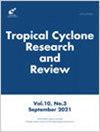关于改进热带气旋形成和位置概率预报产品的建议
IF 4.1
4区 地球科学
Q3 METEOROLOGY & ATMOSPHERIC SCIENCES
引用次数: 0
摘要
对热带气旋登陆的潜在破坏性影响的预测主要依赖于数值预测系统。由于TC的可预测性有限,需要表达预测置信度和可能的情景,因此在实际TC预报和预警中利用动态集合预报的优势至关重要。RSMCs、twcs和其他预报中心重视对tc的概率指导,但国际热带气旋研讨会(IWTC-9)发现,利用这些预报将概率信息“拉通”到操作警报是缓慢的。IWTC-9的建议促成了WMO/WWRP热带气旋概率预报产品(TC-PFP)项目的形成,该项目也被批准为WMO无缝GDPFS试点项目。TC- pfp的主要目标是协调各预测中心,以帮助确定概率TC预测的最佳实践指导。TC- pfp分三个阶段实施:第一阶段(TC形成和定位);第二阶段(TC强度和结构);第三阶段(与热带风暴有关的雨量及风暴潮)。本文对第一阶段进行了总结,并对TC形成和位置概率预测的科学现状进行了综述。基于集合信息的预测产品的性质和解释存在相当大的可变性,这使得在预测中心之间传递最佳实践知识具有挑战性。预报中心之间就不同方法的有效性进行沟通将有助于传达最佳做法。与经验丰富的专家密切合作,交流复杂的概率性TC信息,并在中心之间分享最佳实践,将有助于确保根据TC预测做出有效决策。最后,预报中心需要及时访问具有一致的、用户友好的集成信息的集成信息。在数据可访问性、概率预测产品、预警及其与用户的沟通方面,各预测中心之间更大的一致性将产生更可靠的信息并支持改进的结果。本文章由计算机程序翻译,如有差异,请以英文原文为准。
Recommendations for improved tropical cyclone formation and position probabilistic Forecast products
Prediction of the potentially devastating impact of landfalling tropical cyclones (TCs) relies substantially on numerical prediction systems. Due to the limited predictability of TCs and the need to express forecast confidence and possible scenarios, it is vital to exploit the benefits of dynamic ensemble forecasts in operational TC forecasts and warnings. RSMCs, TCWCs, and other forecast centers value probabilistic guidance for TCs, but the International Workshop on Tropical Cyclones (IWTC-9) found that the “pull-through” of probabilistic information to operational warnings using those forecasts is slow. IWTC-9 recommendations led to the formation of the WMO/WWRP Tropical Cyclone-Probabilistic Forecast Products (TC-PFP) project, which is also endorsed as a WMO Seamless GDPFS Pilot Project. The main goal of TC-PFP is to coordinate across forecast centers to help identify best practice guidance for probabilistic TC forecasts. TC-PFP is being implemented in 3 phases: Phase 1 (TC formation and position); Phase 2 (TC intensity and structure); and Phase 3 (TC related rainfall and storm surge). This article provides a summary of Phase 1 and reviews the current state of the science of probabilistic forecasting of TC formation and position. There is considerable variability in the nature and interpretation of forecast products based on ensemble information, making it challenging to transfer knowledge of best practices across forecast centers. Communication among forecast centers regarding the effectiveness of different approaches would be helpful for conveying best practices. Close collaboration with experts experienced in communicating complex probabilistic TC information and sharing of best practices between centers would help to ensure effective decisions can be made based on TC forecasts. Finally, forecast centers need timely access to ensemble information that has consistent, user-friendly ensemble information. Greater consistency across forecast centers in data accessibility, probabilistic forecast products, and warnings and their communication to users will produce more reliable information and support improved outcomes.
求助全文
通过发布文献求助,成功后即可免费获取论文全文。
去求助
来源期刊

Tropical Cyclone Research and Review
METEOROLOGY & ATMOSPHERIC SCIENCES-
CiteScore
4.60
自引率
3.40%
发文量
184
审稿时长
30 weeks
期刊介绍:
Tropical Cyclone Research and Review is an international journal focusing on tropical cyclone monitoring, forecasting, and research as well as associated hydrological effects and disaster risk reduction. This journal is edited and published by the ESCAP/WMO Typhoon Committee (TC) and the Shanghai Typhoon Institute of the China Meteorology Administration (STI/CMA). Contributions from all tropical cyclone basins are welcome.
Scope of the journal includes:
• Reviews of tropical cyclones exhibiting unusual characteristics or behavior or resulting in disastrous impacts on Typhoon Committee Members and other regional WMO bodies
• Advances in applied and basic tropical cyclone research or technology to improve tropical cyclone forecasts and warnings
• Basic theoretical studies of tropical cyclones
• Event reports, compelling images, and topic review reports of tropical cyclones
• Impacts, risk assessments, and risk management techniques related to tropical cyclones
 求助内容:
求助内容: 应助结果提醒方式:
应助结果提醒方式:


